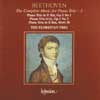Beethoven (The) Complete Music for Piano Trio, Vol 3
The third volume of the Florestan’s Beethoven lives up to their high standards
View record and artist detailsRecord and Artist Details
Composer or Director: Ludwig van Beethoven
Genre:
Chamber
Label: Hyperion
Magazine Review Date: 6/2004
Media Format: CD or Download
Media Runtime: 72
Mastering:
Stereo
DDD
Catalogue Number: CDA67393

Tracks:
| Composition | Artist Credit |
|---|---|
| Piano Trios, Movement: No. 1 in E flat, Op. 1/1 |
Ludwig van Beethoven, Composer
Florestan Trio Ludwig van Beethoven, Composer |
| Piano Trios, Movement: No. 2 in G, Op. 1/2 |
Ludwig van Beethoven, Composer
Florestan Trio Ludwig van Beethoven, Composer |
| Piano Trios, Movement: No. 8 in E flat, WoO38 |
Ludwig van Beethoven, Composer
Florestan Trio Ludwig van Beethoven, Composer |
Author: DuncanDruce
The Florestan Trio seems determined to extract every last ounce of energy, wit and spirit from these early works. Op No 2’s finale, for example, fizzes along; all Beethoven’s surprising inventions and transformations grab our attention, and the whole piece is evidently as much fun to play as to listen to. The principal vehicle for conveying the music’s brightness and verve is Susan Tomes’s finger-work, wonderfully precise and rhythmical, though Anthony Marwood and Richard Lester also play with fine spirit and character. The two Op 1 slow movements are taken at flowing speeds, and allow for some relaxation of mood – Marwood’s entry at the start of No 2’s Largo is particularly poetic – but it’s the bouncy, extrovert character of the Allegros and Prestos that leaves the strongest impression.
The Gryphon Trio’s approach to Op 1 No 1 is very different. With slightly more relaxed tempi they can give more weight to those passages in the first movement that have an air of solemnity. The third movement’s trio, taken more slowly than the Scherzo, makes a more beautiful, tranquil effect than the Florestan, who maintain the tempo, can achieve. And the Gryphon’s second movement, though surely too slow for an 18th-century Adagio cantabile, is sustained by superb phrasing and creates an intense, inward impression that the Florestan can’t quite match. The earlier E flat Trio (WoO, from 1790-91), robustly played, emerges in Beethovenian high spirits, but it reminds us what a leap forward Beethoven made with his Op 1.
The Gryphon Trio’s approach to Op 1 No 1 is very different. With slightly more relaxed tempi they can give more weight to those passages in the first movement that have an air of solemnity. The third movement’s trio, taken more slowly than the Scherzo, makes a more beautiful, tranquil effect than the Florestan, who maintain the tempo, can achieve. And the Gryphon’s second movement, though surely too slow for an 18th-century Adagio cantabile, is sustained by superb phrasing and creates an intense, inward impression that the Florestan can’t quite match. The earlier E flat Trio (WoO, from 1790-91), robustly played, emerges in Beethovenian high spirits, but it reminds us what a leap forward Beethoven made with his Op 1.
Discover the world's largest classical music catalogue with Presto Music.

Gramophone Digital Club
- Digital Edition
- Digital Archive
- Reviews Database
- Full website access
From £8.75 / month
Subscribe
Gramophone Full Club
- Print Edition
- Digital Edition
- Digital Archive
- Reviews Database
- Full website access
From £11.00 / month
Subscribe
If you are a library, university or other organisation that would be interested in an institutional subscription to Gramophone please click here for further information.




